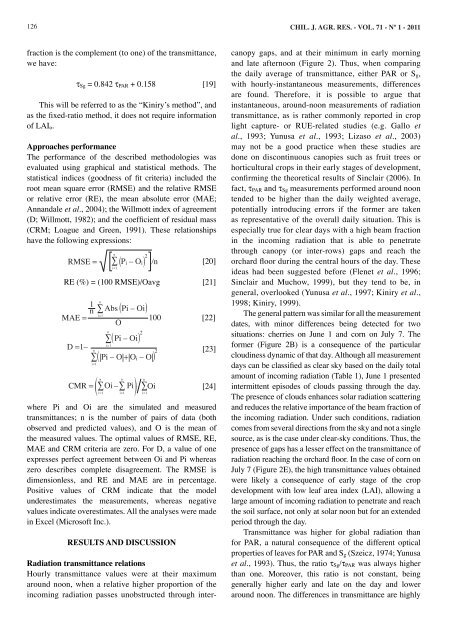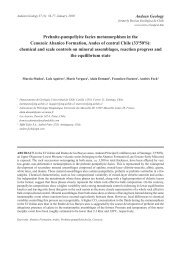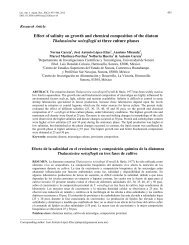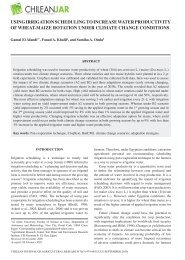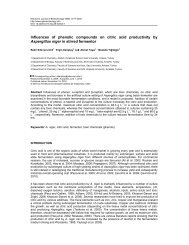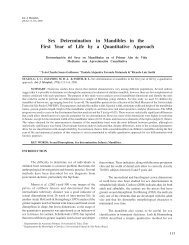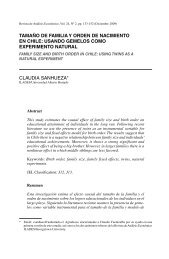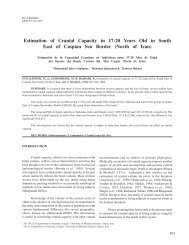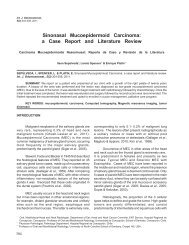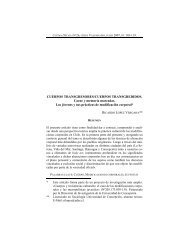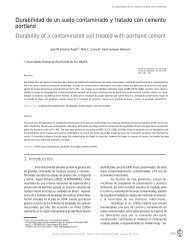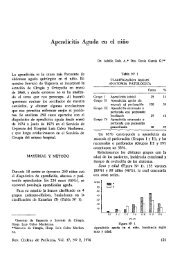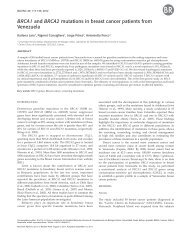(par) and global solar radiation transmittance t
(par) and global solar radiation transmittance t
(par) and global solar radiation transmittance t
You also want an ePaper? Increase the reach of your titles
YUMPU automatically turns print PDFs into web optimized ePapers that Google loves.
126 CHIL. J. AGR. RES. - VOL. 71 - Nº 1 - 2011<br />
fraction is the complement (to one) of the <strong>transmittance</strong>,<br />
we have:<br />
τ Sg = 0.842 τ PAR + 0.158 [19]<br />
This will be referred to as the “Kiniry’s method”, <strong>and</strong><br />
as the fixed-ratio method, it does not require information<br />
of LAI o.<br />
Approaches performance<br />
The performance of the described methodologies was<br />
evaluated using graphical <strong>and</strong> statistical methods. The<br />
statistical indices (goodness of fit criteria) included the<br />
root mean square error (RMSE) <strong>and</strong> the relative RMSE<br />
or relative error (RE), the mean absolute error (MAE;<br />
Ann<strong>and</strong>ale et al., 2004); the Willmott index of agreement<br />
(D; Willmott, 1982); <strong>and</strong> the coefficient of residual mass<br />
(CRM; Loague <strong>and</strong> Green, 1991). These relationships<br />
have the following expressions:<br />
∑ n<br />
i=1<br />
( ) 2<br />
RMSE = P i – O i /n<br />
[20]<br />
RE (%) = (100 RMSE)/Oavg [21]<br />
( )<br />
1<br />
∑ n<br />
n Abs Pi – Oi<br />
i=1<br />
MAE = 100<br />
O<br />
∑ n<br />
( Pi – Oi) 2<br />
i=1<br />
D =1–<br />
∑ n<br />
|Pi – O|+|O i – O|<br />
i=1<br />
( ) 2<br />
( ∑ n<br />
CMR = Oi – Pi<br />
i=1<br />
∑ n<br />
i=1<br />
[22]<br />
[23]<br />
[24]<br />
where Pi <strong>and</strong> Oi are the simulated <strong>and</strong> measured<br />
<strong>transmittance</strong>s; n is the number of pairs of data (both<br />
observed <strong>and</strong> predicted values), <strong>and</strong> O is the mean of<br />
the measured values. The optimal values of RMSE, RE,<br />
MAE <strong>and</strong> CRM criteria are zero. For D, a value of one<br />
expresses perfect agreement between Oi <strong>and</strong> Pi whereas<br />
zero describes complete disagreement. The RMSE is<br />
dimensionless, <strong>and</strong> RE <strong>and</strong> MAE are in percentage.<br />
Positive values of CRM indicate that the model<br />
underestimates the measurements, whereas negative<br />
values indicate overestimates. All the analyses were made<br />
in Excel (Microsoft Inc.).<br />
RESULTS AND DISCUSSION<br />
(<br />
∑Oi<br />
n<br />
i=1<br />
Radiation <strong>transmittance</strong> relations<br />
Hourly <strong>transmittance</strong> values were at their maximum<br />
around noon, when a relative higher proportion of the<br />
incoming <strong>radiation</strong> passes unobstructed through intercanopy<br />
gaps, <strong>and</strong> at their minimum in early morning<br />
<strong>and</strong> late afternoon (Figure 2). Thus, when com<strong>par</strong>ing<br />
the daily average of <strong>transmittance</strong>, either PAR or S g,<br />
with hourly-instantaneous measurements, differences<br />
are found. Therefore, it is possible to argue that<br />
instantaneous, around-noon measurements of <strong>radiation</strong><br />
<strong>transmittance</strong>, as is rather commonly reported in crop<br />
light capture- or RUE-related studies (e.g. Gallo et<br />
al., 1993; Yunusa et al., 1993; Lizaso et al., 2003)<br />
may not be a good practice when these studies are<br />
done on discontinuous canopies such as fruit trees or<br />
horticultural crops in their early stages of development,<br />
confirming the theoretical results of Sinclair (2006). In<br />
fact, τ PAR <strong>and</strong> τ Sg measurements performed around noon<br />
tended to be higher than the daily weighted average,<br />
potentially introducing errors if the former are taken<br />
as representative of the overall daily situation. This is<br />
especially true for clear days with a high beam fraction<br />
in the incoming <strong>radiation</strong> that is able to penetrate<br />
through canopy (or inter-rows) gaps <strong>and</strong> reach the<br />
orchard floor during the central hours of the day. These<br />
ideas had been suggested before (Flenet et al., 1996;<br />
Sinclair <strong>and</strong> Muchow, 1999), but they tend to be, in<br />
general, overlooked (Yunusa et al., 1997; Kiniry et al.,<br />
1998; Kiniry, 1999).<br />
The general pattern was similar for all the measurement<br />
dates, with minor differences being detected for two<br />
situations: cherries on June 1 <strong>and</strong> corn on July 7. The<br />
former (Figure 2B) is a consequence of the <strong>par</strong>ticular<br />
cloudiness dynamic of that day. Although all measurement<br />
days can be classified as clear sky based on the daily total<br />
amount of incoming <strong>radiation</strong> (Table 1), June 1 presented<br />
intermittent episodes of clouds passing through the day.<br />
The presence of clouds enhances <strong>solar</strong> <strong>radiation</strong> scattering<br />
<strong>and</strong> reduces the relative importance of the beam fraction of<br />
the incoming <strong>radiation</strong>. Under such conditions, <strong>radiation</strong><br />
comes from several directions from the sky <strong>and</strong> not a single<br />
source, as is the case under clear-sky conditions. Thus, the<br />
presence of gaps has a lesser effect on the <strong>transmittance</strong> of<br />
<strong>radiation</strong> reaching the orchard floor. In the case of corn on<br />
July 7 (Figure 2E), the high <strong>transmittance</strong> values obtained<br />
were likely a consequence of early stage of the crop<br />
development with low leaf area index (LAI), allowing a<br />
large amount of incoming <strong>radiation</strong> to penetrate <strong>and</strong> reach<br />
the soil surface, not only at <strong>solar</strong> noon but for an extended<br />
period through the day.<br />
Transmittance was higher for <strong>global</strong> <strong>radiation</strong> than<br />
for PAR, a natural consequence of the different optical<br />
properties of leaves for PAR <strong>and</strong> S g (Szeicz, 1974; Yunusa<br />
et al., 1993). Thus, the ratio τ Sg/τ PAR was always higher<br />
than one. Moreover, this ratio is not constant, being<br />
generally higher early <strong>and</strong> late on the day <strong>and</strong> lower<br />
around noon. The differences in <strong>transmittance</strong> are highly


